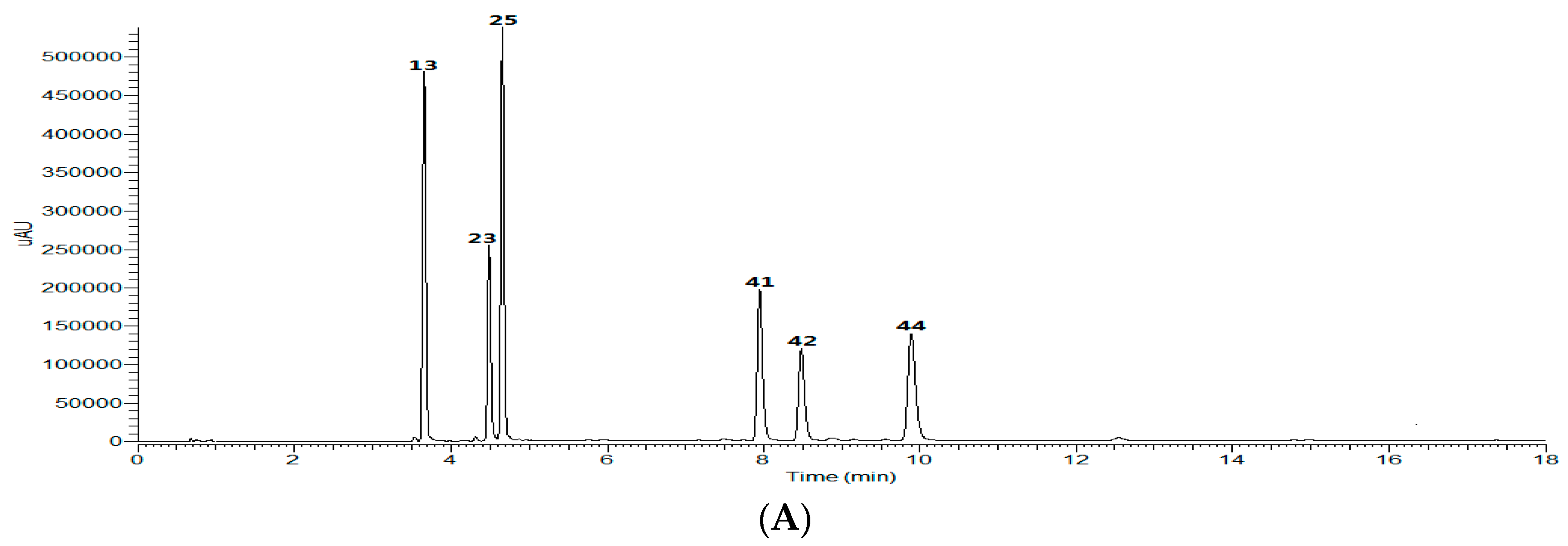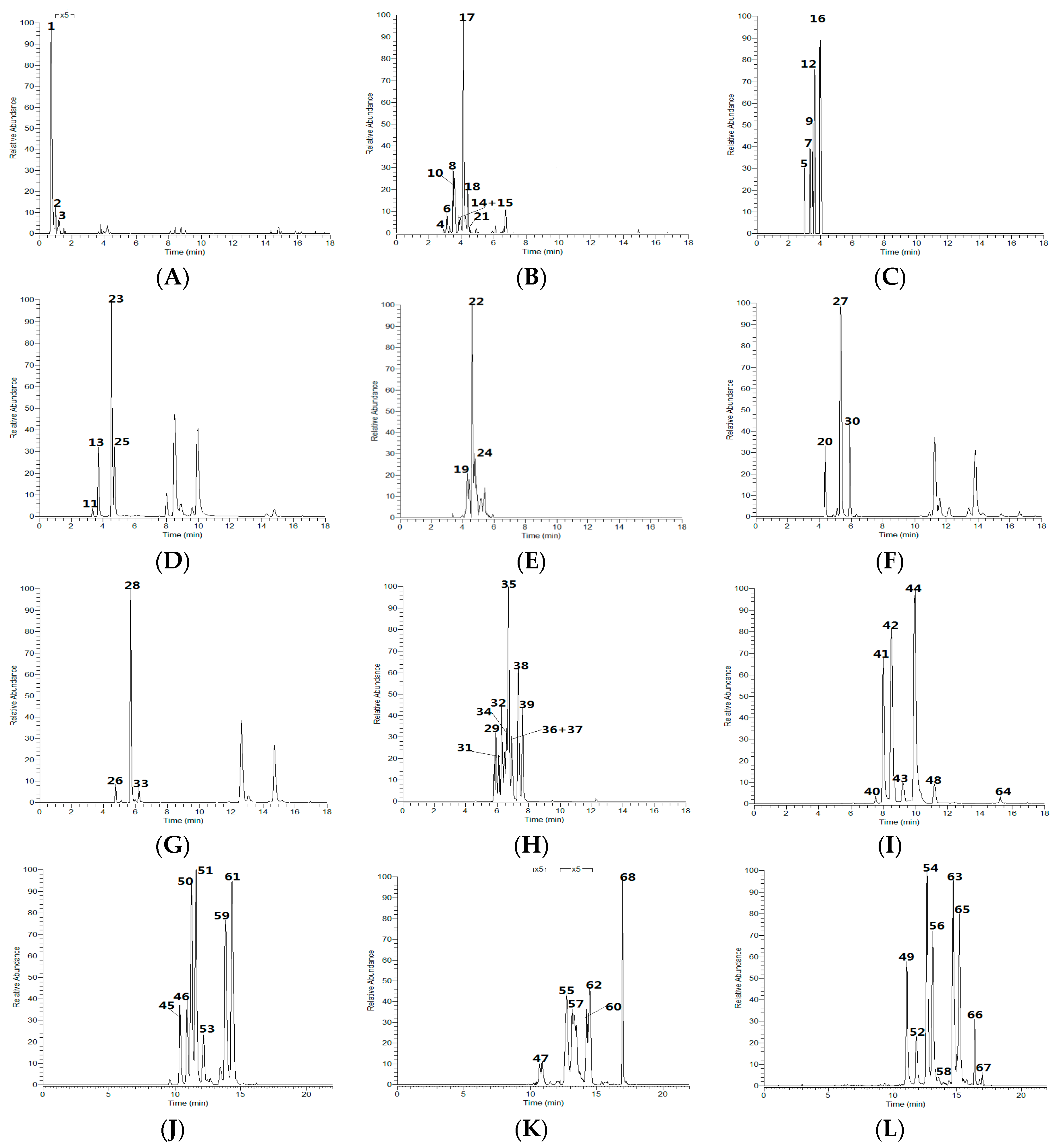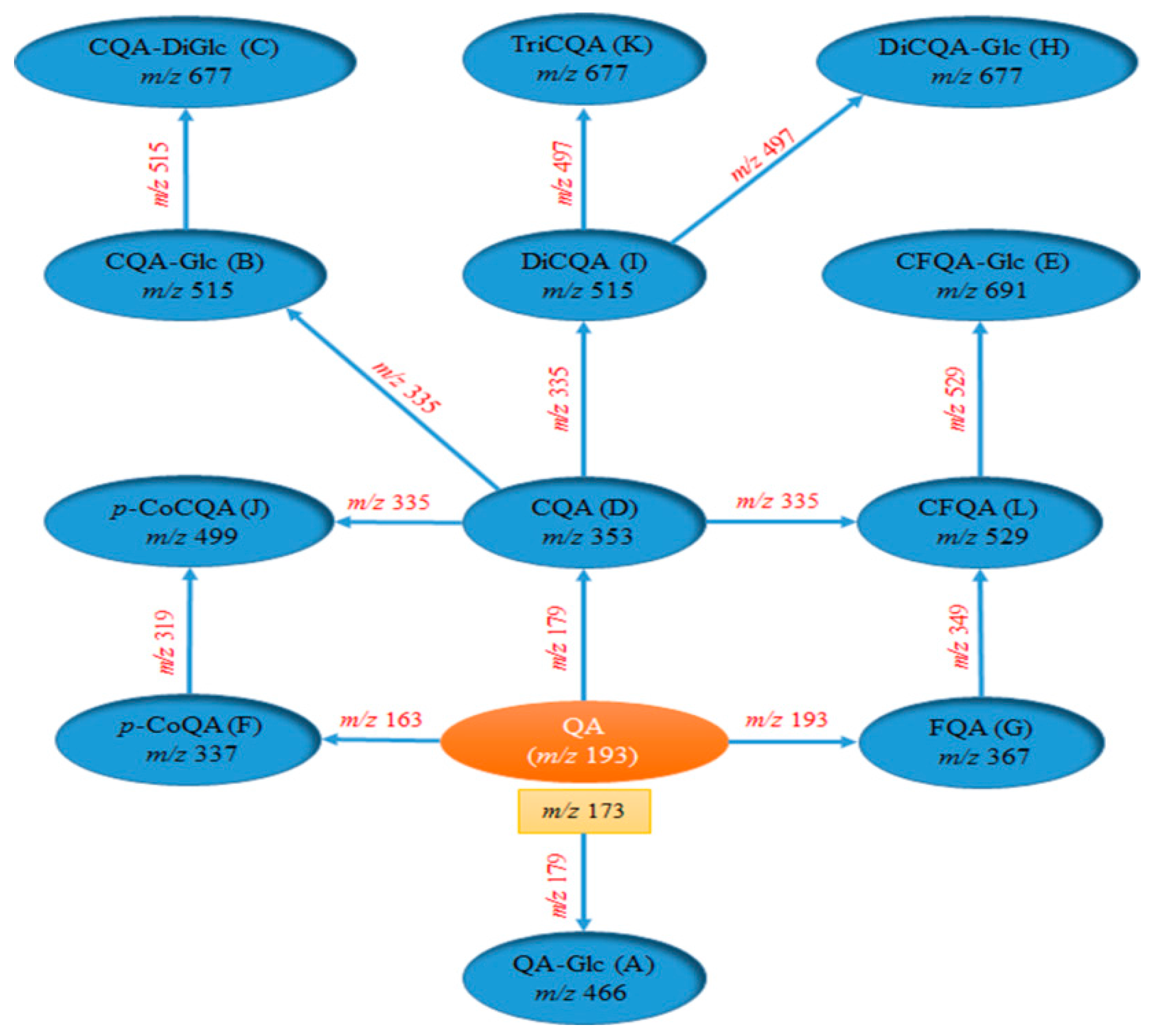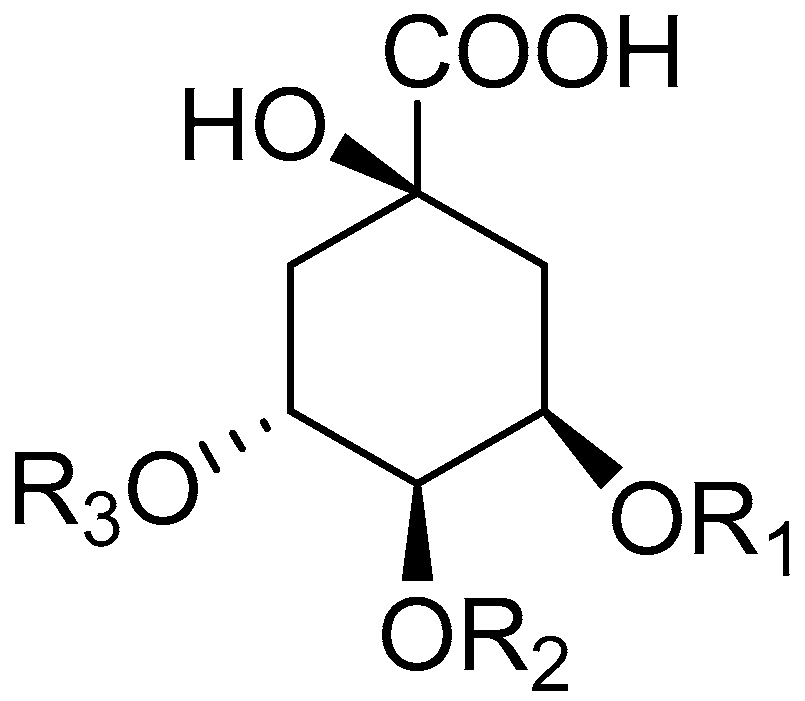Simultaneous Qualitation and Quantitation of Chlorogenic Acids in Kuding Tea Using Ultra-High-Performance Liquid Chromatography–Diode Array Detection Coupled with Linear Ion Trap–Orbitrap Mass Spectrometer
Abstract
:1. Introduction
2. Results and Discussion
2.1. Optimum Conditions for UHPLC-DAD-LTQ-Orbitrap MS Analysis
2.2. Determination of DPIs for CGAs Identification
2.3. Characterization of Isomeric Monoacyl CGAs and Their Glycosides
2.4. Characterization of Isomeric Diacyl CGAs and Their Glycosides
2.5. Characterization of Isomeric Triacyl CGAs
2.6. The Analytical Method Validation and Application
2.7. Discussion
3. Materials and Methods
3.1. Materials and Chemicals
3.2. Standard Solutions and Sample Preparation
3.3. UHPLC-DAD-LTQ-Orbitrap MSn Analysis
3.4. Analytical Methods Validation
3.5. Peak Selections and Data Processing
4. Conclusions
Acknowledgments
Author Contributions
Conflicts of Interest
References
- Jiangsu New Medical College. Dictionary of Traditional Chinese Medicine; Shanghai Scientific and Technical Publishers: Shanghai, China, 1986; p. 1288. (In Chinese) [Google Scholar]
- Liu, L.X.; Sun, Y.; Laura, T.; Liang, X.F.; Ye, H.; Zeng, X.X. Determination of polyphemolic content and antioxidant activity of kudingcha made from Ilex Kudingcha C.J. Tseng. Food Chem. 2009, 112, 35–41. [Google Scholar] [CrossRef]
- Thuong, P.T.; Su, N.D.; Ngoc, T.M.; Hung, T.M.; Dang, N.H.; Thuan, N.D.; Bae, K.H.; Oh, W.K. Antioxidant activity and principles of Vietnam bitter tea Ilex Kudingcha. Food Chem. 2009, 113, 139–145. [Google Scholar] [CrossRef]
- Fan, S.G.; Zhang, Y.; Hu, N.; Sun, Q.H.; Ding, X.B.; Li, G.W.; Zheng, B.; Gu, M.; Huang, F.S.; Sun, Y.Q.; et al. Extract of Kuding tea prevents high-fat diet-induced metabolic disorders in C57BL/6 mice via liver X receptor (LXR) β antagonism. PLoS ONE 2012, 7, e51007. [Google Scholar] [CrossRef] [PubMed]
- Song, C.W.; Xie, C.; Zhou, Z.W.; Yu, S.G.; Yu, S.G.; Fang, N.B. Antidiabetic effect of an active components group from Ilex Kudingcha and its chemical composition. Evid. Based Complement. Altern. Med. 2012, 2012, 423690. [Google Scholar] [CrossRef] [PubMed]
- Xu, D.; Wang, Q.; Zhang, W.; Hu, B.; Zhou, L.; Zeng, X.; Sun, Y. Inhibitory activities of caffeoylquinic acid derivatives from Ilex kudingcha C.J. Tseng on α-glucosidase from Saccharomyces cerevisiae. J. Agric. Food Chem. 2015, 63, 3694–3703. [Google Scholar] [CrossRef] [PubMed]
- Song, J.L.; Qian, Y.; Li, G.J.; Zhao, X. Anti-inflammatory effects of kudingcha methanol extract (Ilex Kudingcha C.J. Tseng) in dextran sulfate sodium-induced ulcerative colitis. Mol. Med. Rep. 2013, 8, 1256–1262. [Google Scholar] [PubMed]
- Zheng, J.; Zhou, H.Y.; Zhao, Y.F.; Lun, Q.X.; Liu, B.L.; Tu, P.F. Triterpenoid-enriched extract of Ilex Kudingcha inhibits aggregated LDL-induced lipid deposition in macrophages by downregulating low density lipoprotein receptor-related protein 1 (LRP1). J. Funct. Foods 2015, 18, 643–652. [Google Scholar] [CrossRef]
- Kai, Z.; Li, G.J.; Sun, P.; Wang, R.; Qian, Y.; Zhao, X. In vitro and in vivo anti-cancer activities of Kuding tea (Ilex Kudingcha C.J. Tseng) against oral cancer. Exp. Ther. Med. 2014, 7, 709–715. [Google Scholar]
- Clifford, M.N.; Marks, S.; Knight, S.; Kuhnert, N. Characterization by LC-MS(n) of four new classes of p-coumaric acid-containing diacyl chlorogenic acids in green coffee beans. J. Agric. Food Chem. 2006, 54, 4095–4101. [Google Scholar] [CrossRef] [PubMed]
- Michael, N.C. Chlorogenic acids and other cinnamates-nature, occurrence, dietary burden, absorption and metabolism. J. Sci. Food Agric. 2000, 80, 1033–1043. [Google Scholar]
- Wang, Q.C.; Zhang, X.; Zhang, W.Q.; Sun, X.Q.; Hu, B.; Sun, Y.; Zeng, X.X. Purification and HPLC analysis of caffeoylquinic acids from Kudingcha made from Ilex Kudingcha C.J. Tseng. Food Sci. 2013, 34, 119–122. [Google Scholar]
- Liu, A.Y.; Che, Y.Y.; Wang, F.; Shang, Z.P.; Lu, J.Q.; Dai, S.Y.; Zhang, J.Y.; Cai, W. Identification of metabolites of 6′-hydroxy-3,4,5,2′,4′-pentamethoxychalcone in rats by a combination of ultra-high-performance liquid chromatography with linear ion trap-Orbitrap mass spectrometry based on multiple data processing techniques. Molecules 2016, 21, 1266. [Google Scholar] [CrossRef] [PubMed]
- Sun, M.H.; Luo, Z.Q.; Liu, Y.; Yang, R.R.; Lu, L.; Yu, G.H.; Ma, X.Y.; Liu, A.X.; Guo, Y.F.; Zhao, Y.H. Identification of the major components of Buddleja officinalis extract and their metabolites in rat urine by UHPLC-LTQ-Orbitrap. J. Food Sci. 2016, 81, H2587–H2596. [Google Scholar] [CrossRef] [PubMed]
- Zhang, J.Y.; Wang, Z.J.; Li, Y.; Liu, Y.; Cai, W.; Li, C.; Lu, J.Q.; Qiao, Y.J. A strategy for comprehensive identification of sequential constituents using ultra-high-performance liquid chromatography coupled with linear ion trap-Orbitrap mass spectrometer, application study on chlorogenic acids in Flos Lonicerae Japonicae. Talanta 2016, 147, 16–27. [Google Scholar] [CrossRef] [PubMed]
- Wang, T.H.; Zhang, J.; Qiu, X.H.; Bai, J.Q.; Gao, Y.H.; Xu, W. Application of Ultra-High-Performance liquid chromatography Coupled with LTQ-Orbitrap Mass spectrometry for the qualitative and quantitative analysis of Polygonum multiflorum Thumb. and its processed products. Molecules 2016, 21, 40. [Google Scholar] [CrossRef] [PubMed]
- Zhang, J.X.; Guan, S.H.; Sun, J.H.; Liu, T.; Chen, P.; Feng, R.H.; Chen, X.; Wu, W.Y.; Yang, M.; Guo, D.A. Characterization and profiling of phenolic amides from Cortex Lycii by ultra-high performance liquid chromatography coupled with LTQ-Orbitrap mass spectrometry. Anal. Bioanal. Chem. 2015, 407, 581–595. [Google Scholar] [CrossRef] [PubMed]
- Makarov, A.; Denisov, E.; Lange, O.; Horning, S. Dynamic range of mass accuracy in LTQ Orbitrap hybrid mass spectrometer. J. Am. Soc. Mass Spectrom. 2006, 17, 977–982. [Google Scholar] [CrossRef] [PubMed]
- Zhang, J.Y.; Zhang, Q.; Li, N.; Wang, Z.J.; Lu, J.Q.; Qiao, Y.J. Diagnostic fragment-ion-based and extension strategy coupled to DFIs intensity analysis for identification of chlorogenic acids isomers in Flos Lonicerae Japonicae by HPLC-ESI-MSn. Talanta 2013, 104, 1–9. [Google Scholar] [CrossRef] [PubMed]
- Schram, K.; Miketova, P.; Slanina, J.; Humpa, O.; Taborska, E. Mass spectrometry of 1,3- and 1,5-dicaffeoylquinic acids. J. Mass Spectrom. 2004, 139, 384–395. [Google Scholar] [CrossRef] [PubMed]
- Clifford, M.N.; Johnson, K.L.; Knight, S.; Kuhnert, N. Hierarchical scheme for LC-MSn identification of chlorogenic acids. J. Agric. Food Chem. 2003, 51, 2900–2911. [Google Scholar] [CrossRef] [PubMed]
- Wang, Z.; Clifford, M.N. Comparison of the profiles chlorogenic acids and their derivatives from three Chinese traditional herbs by LC-MSn. Acta Pharm. Sin. 2008, 43, 185–190. [Google Scholar]
- Wang, J.; Wang, N.L.; Yao, X.S.; Susumu, K.A. Caffeoylquinic acid derivatives from Bidens parviflora and their antihistamine release activities. Chin. Tradit. Herb. Drugs 2006, 37, 966–970. [Google Scholar]
- Sample Availability: Samples of the compounds 3-CQA, 4-CQA, 5-CQA, 3,4-diCQA, 3,5-diCQA and 4,5-diCQA are available from the authors.





| Peak | Compound | R1 | R2 | R3 |
| 13 | 3-CQA | caffeoyl | H | H |
| 23 | 5-CQA | H | H | caffeoyl |
| 25 | 4-CQA | H | caffeoyl | H |
| 41 | 3,4-diCQA | caffeoyl | caffeoyl | H |
| 42 | 3,5-diCQA | caffeoyl | H | caffeoyl |
| 44 | 4,5-diCQA | H | caffeoyl | caffeoyl |
 caffeoyl.
caffeoyl.| Compounds | Regression Equation | Linear Range (μg·mL−1) | r2 | LOD (ng) | LOQ (ng) |
|---|---|---|---|---|---|
| 3-CQA | Y = 5349.43X − 7565.80 | 0.978–97.8 | 1.0000 | 0.247 | 0.796 |
| 5-CQA | Y = 1243.65X − 6508.24 | 1.426–142.6 | 0.9999 | 0.132 | 0.431 |
| 4-CQA | Y = 2558.74X − 17847.34 | 1.623–162.3 | 0.9999 | 0.146 | 0.597 |
| 3,4-DiCQA | Y = 1761.60X − 13189.53 | 1.412–141.2 | 1.0000 | 1.108 | 3.232 |
| 3,5-DiCQA | Y = 1587.92X − 10835.65 | 1.060–106.0 | 0.9999 | 0.211 | 0.674 |
| 4,5-DiCQA | Y = 1495.94X − 15781.81 | 1.714–171.4 | 1.0000 | 0.124 | 0.479 |
| Compounds | Intra-Day Pecision RSD (%) | Inter-Day Precision | Repeatability RSD (%) | Recovery | |
|---|---|---|---|---|---|
| RSD (%) | Recovery (%) | RSD (%) | |||
| 3-CQA | 1.02 | 1.45 | 1.19 | 101.40 | 1.99 |
| 5-CQA | 0.88 | 1.29 | 1.23 | 101.61 | 2.03 |
| 4-CQA | 0.79 | 1.58 | 1.22 | 98.62 | 2.85 |
| 3,4-DiCQA | 1.74 | 1.31 | 1.17 | 96.40 | 1.79 |
| 3,5-DiCQA | 0.91 | 1.29 | 1.27 | 99.88 | 2.46 |
| 4,5-DiCQA | 1.08 | 1.22 | 1.24 | 97.95 | 1.63 |
| Compounds | Content (mg/g) | |||||||
|---|---|---|---|---|---|---|---|---|
| S1 | S2 | S3 | S4 | S5 | S6 | S7 | S8 | |
| 3-CQA | 3.29 | 4.05 | 3.53 | 2.28 | 4.48 | 3.37 | 3.12 | 4.45 |
| 5-CQA | 29.74 | 18.51 | 18.74 | 16.32 | 22.29 | 30.51 | 17.93 | 19.12 |
| 4-CQA | 2.87 | 1.99 | 2.37 | 2.16 | 2.69 | 2.59 | 4.01 | 2.89 |
| 3,4-DiCQA | 5.37 | 4.26 | 5.34 | 5.08 | 7.84 | 4.51 | 1.47 | 5.04 |
| 3,5-DiCQA | 37.49 | 40.17 | 37.36 | 45.14 | 39.02 | 52.18 | 23.94 | 41.98 |
| 4,5-DiCQA | 28.36 | 32.15 | 19.30 | 27.26 | 26.19 | 30.32 | 29.11 | 22.72 |
| Total | 105.12 | 98.13 | 84.64 | 97.24 | 99.51 | 121.48 | 79.58 | 93.20 |
| No. | tR/min | Formula [M − H]− | Theoretical Mass m/z | Experimental Mass m/z | Error/ppm | MSn (m/z) P-ion (%) b | Identification |
|---|---|---|---|---|---|---|---|
| 1 | 0.72 | C13H21O11 | 353.1078 | 353.1080 | 0.37 | MS2[353]: 173(100), 191(44), 111(23) | QA-Glc-1 |
| 2 | 0.97 | C13H21O11 | 353.1078 | 353.1085 | 1.76 | MS2[353]: 173(100), 191(41) | QA-Glc-2 |
| 3 | 1.20 | C13H21O11 | 353.1078 | 353.1090 | 3.23 | MS2[353]: 173(100), 191(38), 111(28) | QA-Glc-3 |
| 4 | 2.91 | C22H27O14 | 515.1395 | 515.1409 | 2.60 | MS2[515]: 353(100), 191(49) | CQA-Glc-1 |
| 5 | 2.97 | C28H37O19 | 677.1924 | 677.1951 | 4.10 | MS2[677]: 353(100), 631(54) | CQA-DiGlc-1 |
| 6 | 3.11 | C22H27O14 | 515.1395 | 515.1415 | 3.78 | MS2[515]: 341(100), 179(90), 353(67), 191(27) | CQA-Glc-2 |
| 7 | 3.31 | C28H37O19 | 677.1924 | 677.1893 | 4.21 | MS2[677]: 353(100), 633(30), 515(12.3) | CQA-DiGlc-2 |
| 8 | 3.47 | C22H27O14 | 515.1395 | 515.1409 | 2.71 | MS2[515]: 353(100), 191(81), 179(4) | CQA-Glc-3 |
| 9 | 3.50 | C28H37O19 | 677.1924 | 677.1934 | 1.48 | MS2[677]: 353(100), 335(80), 515(73) | CQA-DiGlc-3 |
| 10 | 3.56 | C22H27O14 | 515.1395 | 515.1414 | 3.55 | MS2[515]: 341(100), 353(89), 179(59), 173(29) | CQA-Glc-4 |
| 11 | 3.60 | C16H17O9 | 353.0867 | 353.0866 | −0.36 | MS2[353]: 191(100), 179(45), 173(3) | 1-CQA |
| 12 | 3.62 | C28H37O19 | 677.1924 | 677.1916 | −1.04 | MS2[677]: 353(100), 455(46), 395(35), 515(19) | CQA-DiGlc-4 |
| 13 Δ | 3.79 | C16H17O9 | 353.0867 | 353.0869 | 0.57 | MS2[353]: 191(100), 179(45), 135(7), 173(4) | 3-CQA |
| 14 | 3.85 | C22H27O14 | 515.1395 | 515.1410 | 2.95 | MS2[515]: 323(100), 191(27), 353(26) | CQA-Glc-5 |
| 15 | 3.96 | C22H27O14 | 515.1395 | 515.1410 | 2.95 | MS2[515]: 353(100), 191(87) | CQA-Glc-6 |
| 16 | 4.03 | C28H37O19 | 677.1924 | 677.1935 | 1.75 | MS2[677]: 353(100), 335(52), 395(37), 515(31) | CQA-DiGlc-5 |
| 17 | 4.11 | C22H27O14 | 515.1395 | 515.1415 | 3.78 | MS2[515]: 353(100), 191(72), 341(69) | CQA-Glc-7 |
| 18 | 4.26 | C22H27O14 | 515.1395 | 515.1414 | 3.55 | MS2[515]: 471(100), 353(18) | CQA-Glc-8 |
| 19 | 4.29 | C32H35O17 | 691.1869 | 691.1884 | 2.23 | MS2[691]: 353(100), 673(12) | CFQA-Glc-1 |
| 20 | 4.35 | C16H17O8 | 337.0928 | 337.0920 | 0.55 | MS2[337]: 163(100), 191(7), 173(5) | 3-pCoQA |
| 21 | 4.39 | C22H27O14 | 515.1395 | 515.1410 | 2.95 | MS2[515]: 353(100), 529(12) | CQA-Glc-9 |
| 22 | 4.39 | C32H35O17 | 691.1869 | 691.1880 | 1.70 | MS2[691]: 673(100), 529(86), 367(15) | CFQA-Glc-2 |
| 23 Δ | 4.52 | C16H17O9 | 353.0867 | 353.0868 | 0.15 | MS2[353]: 191(100), 179(3) | 5-CQA |
| 24 | 4.58 | C32H35O17 | 691.1869 | 691.1882 | −1.87 | MS2[691]: 529(100), 353(11), 367(5) | CFQA-Glc-3 |
| 25 Δ | 4.68 | C16H17O9 | 353.0867 | 353.0868 | 0.23 | MS2[353]: 173(100), 179(57), 191(27), 135(8) | 4-CQA |
| 26 | 4.75 | C17H19O9 | 367.1024 | 367.1024 | 0.00 | MS2[367]: 193(100), 173(4) | 3-FQA |
| 27 | 5.31 | C16H17O8 | 337.0928 | 337.0916 | −0.72 | MS2[337]: 191(100), 163(4), 173(1) | 5-pCoQA |
| 28 | 5.71 | C17H19O9 | 367.1024 | 367.1035 | 3.16 | MS2[367]: 191(100), 173(5), 191(2) | 5-FQA |
| 29 | 5.81 | C31H33O17 | 677.1712 | 677.1722 | 1.50 | MS2[677]: 353(100), 515(13) | DiCQA-Glc-1 |
| 30 | 5.91 | C16H17O8 | 337.0928 | 337.0915 | −0.99 | MS2[337]: 173(100), 191(75), 163(8) | 4-pCoQA |
| 31 | 5.91 | C31H33O17 | 677.1712 | 677.1722 | 1.50 | MS2[677]: 353(100), 515(85) | DiCQA-Glc-2 |
| 32 | 6.10 | C31H33O17 | 677.1712 | 677.1720 | 1.14 | MS2[677]: 515(100), 353(65) | DiCQA-Glc-3 |
| 33 | 6.20 | C17H19O9 | 367.1024 | 367.1034 | 2.73 | MS2[367]: 173(100), 134(9), 193(3) | 4-FQA |
| 34 | 6.28 | C31H33O17 | 677.1712 | 677.1724 | 1.76 | MS2[677]: 515(100), 353(20) | DiCQA-Glc-4 |
| 35 | 6.48 | C31H33O17 | 677.1712 | 677.1727 | 2.22 | MS2[677]: 515(100), 353(40) | DiCQA-Glc-5 |
| 36 | 6.58 | C31H33O17 | 677.1712 | 677.1713 | 0.05 | MS2[677]: 515(100), 353(46) | DiCQA-Glc-6 |
| 37 | 6.72 | C31H33O17 | 677.1712 | 677.1692 | −2.92 | MS2[677]: 515(100), 609(10), 353(9) | DiCQA-Glc-7 |
| 38 | 7.23 | C31H33O17 | 677.1712 | 677.1724 | 1.67 | MS2[677]: 609(100), 515(89), 353(24) | DiCQA-Glc-8 |
| 39 | 7.46 | C31H33O17 | 677.1712 | 677.1725 | 1.95 | MS2[677]: 515(100), 631(36) | DiCQA-Glc-9 |
| 40 | 7.53 | C25H23O12 | 515.1184 | 515.1200 | 3.10 | MS2[515]: 353(100), 191(34) MS3[515]: 191(100), 179(76), 111(41) | 1,3-DiCQA |
| 41 Δ | 7.99 | C25H23O12 | 515.1184 | 515.1188 | 0.71 | MS2[515]: 353(100), 173(24) MS3[353]: 173(100), 179(68), 191(46) | 3,4-DiCQA |
| 42 Δ | 8.57 | C25H23O12 | 515.1184 | 515.1201 | 3.33 | MS2[515]: 353(100), 191(1) MS3[353]: 191(100), 179(48), 135(12) | 3,5-DiCQA |
| 43 | 9.61 | C25H23O12 | 515.1184 | 515.1200 | 3.10 | MS2[515]: 353(100), 191(38) MS3[353]: 191(100), 179(73), 111(31) | Cis-1,3-DiCQA |
| 44 Δ | 9.96 | C25H23O12 | 515.1184 | 515.1187 | 0.60 | MS2[515]: 353(100), 191(8) MS3[353]: 173(100), 191(89), 179(81) | 4,5-DiCQA |
| 45 | 10.39 | C25H23O11 | 499.1235 | 499.1255 | 3.95 | MS2[499]: 353(100), 335(25), 173(10), 179(8) | pCoCQA-1 |
| 46 | 10.91 | C25H23O11 | 499.1235 | 499.1255 | 4.07 | MS2[499]: 337(100), 173(32), 335(14), 353(4) | pCoCQA-2 |
| 47 | 10.91 | C34H29O15 | 677.1501 | 677.1518 | 2.50 | MS2[677]: 515(100), 497(30) | TriCQA-1 |
| 48 | 11.17 | C25H23O12 | 515.1184 | 515.1176 | −1.54 | MS2[515]: 353(100) MS3[353]: 191(100), 179(19), 135(9) | 1,5-DiCQA |
| 49 | 11.18 | C26H25O12 | 529.1341 | 529.1357 | 3.08 | MS2[529]: 353(100), 367(69) | CFQA-1 |
| 50 | 11.24 | C25H23O11 | 499.1235 | 499.1254 | 3.77 | MS2[499]: 337(100), 335(8), 163(7) | pCoCQA-3 |
| 51 | 11.60 | C25H23O11 | 499.1235 | 499.1255 | 4.07 | MS2[499]: 353(100), 337(13), 191(4), 179(2) | pCoCQA-4 |
| 52 | 11.82 | C26H25O12 | 529.1341 | 529.1354 | 2.51 | MS2[529]: 367(100), 173(28), 179(5) | CFQA-2 |
| 53 | 12.16 | C25H23O11 | 499.1235 | 499.1252 | 3.45 | MS2[499]: 353(100), 337(48), 335(3) | pCoCQA-5 |
| 54 | 12.65 | C26H25O12 | 529.1341 | 529.1354 | 2.62 | MS2[529]: 367(100), 193(5) | CFQA-3 |
| 55 | 12.71 | C34H29O15 | 677.1501 | 677.1513 | 1.79 | MS2[677]: 515(100), 497(40) | TriCQA-2 |
| 56 | 13.11 | C26H25O12 | 529.1341 | 529.1352 | 2.26 | MS2[529]: 353(100), 367(36), 191(9), 179(6) | CFQA-4 |
| 57 | 13.16 | C34H29O15 | 677.1501 | 677.1512 | 1.60 | MS2[677]: 515(100), 497(35), 659(21) | TriCQA-3 |
| 58 | 13.57 | C26H25O12 | 529.1341 | 529.1349 | 1.70 | MS2[529]: 367(100) | CFQA-5 |
| 59 | 13.84 | C25H23O11 | 499.1235 | 499.1252 | 3.45 | MS2[499]: 337(100), 173(10), 335(4), 179(2) | pCoCQA-6 |
| 60 | 14.25 | C34H29O15 | 677.1501 | 677.1514 | 1.88 | MS2[677]: 515(100), 497(29) | TriCQA-4 |
| 61 | 14.35 | C25H23O11 | 499.1235 | 499.1251 | 3.27 | MS2[499]: 353(100), 337(8) | pCoCQA-7 |
| 62 | 14.45 | C34H29O15 | 677.1501 | 677.1506 | 0.70 | MS2[677]: 515(100), 617(66) | TriCQA-5 |
| 63 | 14.73 | C26H25O12 | 529.1341 | 529.1352 | 2.15 | MS2[529]: 353(100), 367(20) | CFQA-6 |
| 64 | 14.80 | C25H23O12 | 515.1184 | 515.1199 | 2.85 | MS2[515]: 353(100), 173(3), 179(2) MS3[353]: 173(100), 179(84), 191(81), 135(13) | 1,4-DiCQA |
| 65 | 15.21 | C26H25O12 | 529.1341 | 529.1355 | 2.73 | MS2[529]: 353(100), 367(21), 203(10), 335(6) | CFQA-7 |
| 66 | 16.38 | C26H25O12 | 529.1341 | 529.1354 | 2.51 | MS2[529]: 367(100), 179(17) | CFQA-8 |
| 67 | 16.96 | C26H25O12 | 529.1341 | 529.1352 | 2.15 | MS2[529]: 367(100), 353(44) | CFQA-9 |
| 68 | 16.96 | C34H29O15 | 677.1501 | 677.1508 | 0.98 | MS2[677]: 515(100), 353(7) | TriCQA-6 |
© 2016 by the authors. Licensee MDPI, Basel, Switzerland. This article is an open access article distributed under the terms and conditions of the Creative Commons Attribution (CC-BY) license ( http://creativecommons.org/licenses/by/4.0/).
Share and Cite
Che, Y.; Wang, Z.; Zhu, Z.; Ma, Y.; Zhang, Y.; Gu, W.; Zhang, J.; Rao, G. Simultaneous Qualitation and Quantitation of Chlorogenic Acids in Kuding Tea Using Ultra-High-Performance Liquid Chromatography–Diode Array Detection Coupled with Linear Ion Trap–Orbitrap Mass Spectrometer. Molecules 2016, 21, 1728. https://doi.org/10.3390/molecules21121728
Che Y, Wang Z, Zhu Z, Ma Y, Zhang Y, Gu W, Zhang J, Rao G. Simultaneous Qualitation and Quantitation of Chlorogenic Acids in Kuding Tea Using Ultra-High-Performance Liquid Chromatography–Diode Array Detection Coupled with Linear Ion Trap–Orbitrap Mass Spectrometer. Molecules. 2016; 21(12):1728. https://doi.org/10.3390/molecules21121728
Chicago/Turabian StyleChe, Yanyun, Zhibin Wang, Zhiyun Zhu, Yangyang Ma, Yaqiong Zhang, Wen Gu, Jiayu Zhang, and Gaoxiong Rao. 2016. "Simultaneous Qualitation and Quantitation of Chlorogenic Acids in Kuding Tea Using Ultra-High-Performance Liquid Chromatography–Diode Array Detection Coupled with Linear Ion Trap–Orbitrap Mass Spectrometer" Molecules 21, no. 12: 1728. https://doi.org/10.3390/molecules21121728





